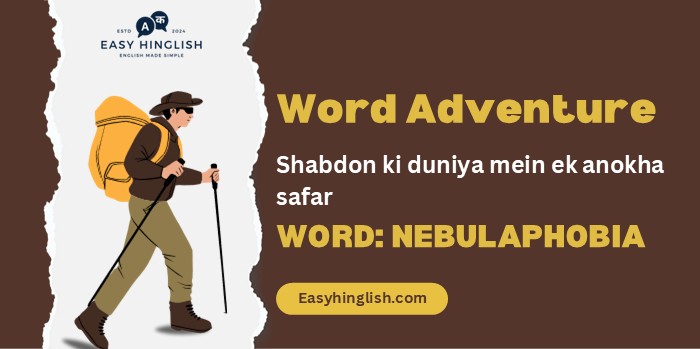Word Adventure: Nebulaphobia
The Headline
“Nebulaphobia: Jab Fog aur Clouds Ban Jate Hain Fear ke Sources”
The Scoop
Phobias ke vast universe mein – woh specific, persistent fears jo millions worldwide ko affect karte hain – kuch apne poetic names aur curious objects of dread ke liye stand out karte hain. ‘Nebulaphobia’ ek aisa hi intriguing fear hai – fog, mist, ya clouds se trigger hone wala intense anxiety. Chaliye dissect karte hain is atmospheric apprehension ko jo ordinary weather phenomena ko significant distress ke sources mein transform kar deta hai affected logo ke liye.
Let’s Break It Down
The Plot Thickens
‘Nebulaphobia’ do classical languages ke elements combine karta hai – Latin word ‘nebula’ aur Greek ‘phobos’. ‘Nebula’ originally Latin mein clouds, mist, ya fog ko refer karta tha, though modern English speakers isse zyada readily astronomy se recognize kar sakte hain, jahan ye interstellar clouds of dust aur gas describe karta hai. ‘Phobos’, Greek word for fear, specific anxieties ko name karne ke liye common suffix ban gaya hai.
Jabki ye most common phobias mein se nahi hai, nebulaphobia illustrate karta hai ki kaise environmental conditions significant anxiety trigger kar sakte hain. Sufferers ke liye, ye experience mere discomfort se far beyond hota hai limited visibility ya dampness ke saath. Fog ya cloudy conditions feelings evoke kar sakte hain trapped, disoriented, ya unseen threats ke liye vulnerable hone ki. Kuch psychologists is fear ko evolutionary responses se connect karte hain – limited visibility indeed humary ancestors ke liye real dangers pose karti thi.
Interestingly, nebulaphobia aksar other related fears ke saath intersect karta hai, jaise homichlophobia (specifically fog ka fear), nephophobia (clouds ka fear), aur even scotomaphobia (blindness ya being unable to see ka fear). Visibility-related anxieties ka ye cluster humein fundamental importance remind karta hai clear perception ki human psychological security ke liye.
Word in the Wild
The Twist
Yahan ek thought-provoking aspect hai nebulaphobia ka: jabki hum sab fog aur clouds ko physical phenomena ke roop mein sochte hain, ye long time se powerful metaphors serve kar rahe hain uncertainty aur confusion ke liye across cultures. Consider kariye expressions jaise “foggy thinking,” “clouded judgment,” ya “being in a fog.” Kisi nebulaphobia wale ke liye, ye linguistic connections ek fascinating double layer of anxiety create kar sakte hain – jahan physical fog fear trigger karta hai, aur metaphorical associations mental confusion ke saath response ko intensify karte hain. Ye suggest karta hai ki kuch phobias sirf direct experience se nahi balki cultural aur linguistic frameworks se bhi reinforce ho sakte hain jo hum inherit karte hain. Shayad “fog” ka hamara collective use as a metaphor for disorientation actual weather phenomenon ko aur bhi threatening feel karata hai un logo ke liye jo is particular fear ke liye predisposed hain.
Make It Stick
Nebulaphobia: Jab Mother Nature ke cotton balls ban jate hain monsters in disguise!
Your Turn
Kya aapne kabhi foggy ya cloudy conditions mein anxiety ya discomfort experience kiya hai? Limited visibility ke kya aspects aapko most challenging lage? Ya phir aap opposite hain – koi aisa jo fog ko mysteriously beautiful ya peaceful lagta hai? Apne atmospheric conditions ke saath experiences share kariye comments mein. Chaliye explore karte hain ki different people in natural phenomena ko kaise respond karte hain aur kya influence kar sakta hai aise varied reactions!
Down the Rabbit Hole
- Fear ki psychology ke baare mein curious hain? Research kariye ‘prepared phobias’, ‘exposure therapy’, ya ‘cognitive-behavioral approaches to anxiety disorders’.
- Fog ki cultural significance mein interested hain? Explore kariye iska use literature mein jaise Dickens ke works, horror films, ya different cultural interpretations of mist across world mythologies.
- Specialized phobias ke baare mein aur understand karna chahte hain? Look into kariye ‘homichlophobia’, ‘ombrophobia’ (rain ka fear), ya ‘chionophobia’ (snow ka fear).
The Last Word
Jaise hum ‘nebulaphobia’ ki exploration ke mists se emerge kar rahe hain, main hope karta hoon ki aapne is specific fear aur phobias ke broader landscape ke baare mein insight gain ki hai jo human experience ko shape karte hain. Chahe common ho ya rare, har phobia humein complex interplay remind karta hai hamari evolutionary history, personal experiences, aur cultural context ke beech. Next time jab aap fog rolling in ya clouds gathering overhead encounter karenge, shayad aap appreciate kar paenge ki kaise ye ordinary atmospheric conditions itne varied reactions evoke kar sakte hain – delight se lekar dread tak. Until humara next word adventure, main hoon Prashant from Wordpandit, aapko encourage karta hoon ki diverse fears ke taraf compassion se dekhiye jo humari human tapestry banate hain!








